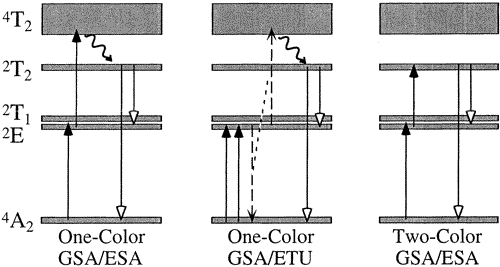Abstract of Publication No. 367
 Daniel R. Gamelin and Hans U. Güdel
Daniel R. Gamelin and Hans U. Güdel
Excited-State Dynamics and Sequential Two-Photon Upconversion Excitation
of Mo3+-Doped Chloro- and Bromo-elpasolites
J. Phys. Chem. B 104, 10222-10234 (2000)
![]()
![]()
Abstract:
The photophysical properties of Mo3+-doped chloro-
and bromo-elpasolites at 10 K and as a function of temperature
are presented. Visible upconverted luminescence is observed with
near-infrared laser excitation, and the properties of this
two-photon excitation process are experimentally characterized
by a variety of luminescence and time-dependent measurements.
Three upconversion mechanisms are active in these Mo3+-doped
materials. Two involve the sequential absorption of two
near-infrared photons of the same color, and a third involves
the sequential absorption of two near-infrared photons of
different colors. The two one-color upconversion mechanisms are
distinguishable on the basis of time dependence measurements and
simulations. Of the three mechanisms, the two-color sequential
two-photon absorption process is found to be more efficient than
the corresponding one-color mechanism by a factor of >102,
and this is related to the relatively small effective spin-orbit
coupling magnitude in this ion. These excited-state processes
are assisted by an extremely long 10 K 2E lifetime of
67.5 ms in 2.5% Mo3+:Cs2NaYCl6,
and 48.5 ms in 2.5% Mo3+:Cs2NaYBr6.
The upconversion properties of Mo3+ presented here
reflect the rich photophysics of this ion, and represent a
significant new addition to the emerging area of
transition-metal upconversion.